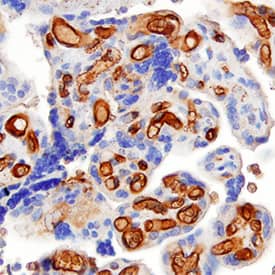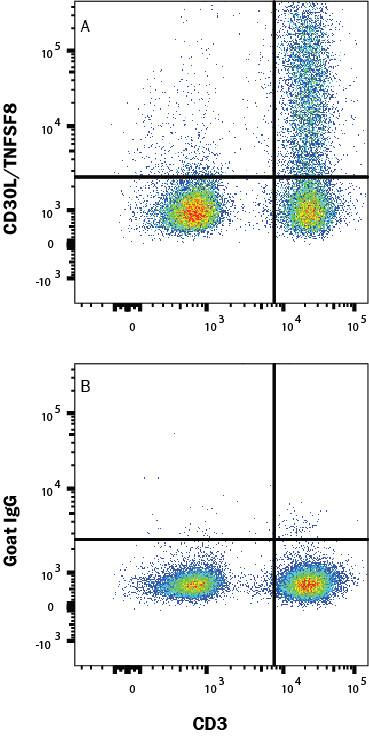Human CD30 Ligand/TNFSF8 Antibody
R&D Systems, part of Bio-Techne | Catalog # AF1028


Key Product Details
Species Reactivity
Validated:
Cited:
Applications
Validated:
Cited:
Label
Antibody Source
Product Specifications
Immunogen
Gln63-Asp234
Accession # P32971
Specificity
Clonality
Host
Isotype
Scientific Data Images for Human CD30 Ligand/TNFSF8 Antibody
CD30 Ligand/TNFSF8 in Human Thymus.
CD30 Ligand/TNFSF8 was detected in immersion fixed paraffin-embedded sections of human thymus using Goat Anti-Human CD30 Ligand/TNFSF8 Antigen Affinity-purified Polyclonal Antibody (Catalog # AF1028) at 0.3 µg/mL for 1 hour at room temperature followed by incubation with the Anti-Goat IgG VisUCyte™ HRP Polymer Antibody (VC004). Tissue was stained using DAB (brown) and counterstained with hematoxylin (blue). Specific staining was localized to Hassall's corpuscles. View our protocol for IHC Staining with VisUCyte HRP Polymer Detection Reagents.CD30 Ligand/TNFSF8 in Human Placenta.
CD30 Ligand/TNFSF8 was detected in immersion fixed paraffin-embedded sections of human placenta using Goat Anti-Human CD30 Ligand/TNFSF8 Antigen Affinity-purified Polyclonal Antibody (Catalog # AF1028) at 0.1 µg/mL for 1 hour at room temperature followed by incubation with the Anti-Goat IgG VisUCyte™ HRP Polymer Antibody (VC004). Tissue was stained using DAB (brown) and counterstained with hematoxylin (blue). Specific staining was localized to endothelial cells in villi. View our protocol for IHC Staining with VisUCyte HRP Polymer Detection Reagents.Detection of CD30 Ligand/TNFSF8 in Human PBMC by Flow Cytometry.
Human PBMC activated with PMA (50 ng/ml) and Ca2+ Ionomycin (200 ng/ml) for 16 hours were stained with (A) Goat Anti-Human CD30 Ligand/TNFSF8 Antigen Affinity-Purified Antibody (Catalog # AF1028) or (B) control antibody (AB-108-C) followed by Phycoerythrin-conjugated Anti-Goat IgG Secondary Antibody (F0107) and Mouse anti-Human CD3 APC-conjugated Monoclonal Antibody (FAB100A). Staining was performed using our Staining Membrane-associated Proteins protocol.Applications for Human CD30 Ligand/TNFSF8 Antibody
CyTOF-ready
Flow Cytometry
Sample: Human peripheral blood mononuclear cells activated with PMA and Ca2+ ionomycin
Immunohistochemistry
Sample: Immersion fixed paraffin-embedded sections of human placenta and human thymus
Western Blot
Sample: Recombinant Human CD30 Ligand/TNFSF8 (Catalog # 1028-CL)
Formulation, Preparation, and Storage
Purification
Reconstitution
Formulation
Shipping
Stability & Storage
- 12 months from date of receipt, -20 to -70 °C as supplied.
- 1 month, 2 to 8 °C under sterile conditions after reconstitution.
- 6 months, -20 to -70 °C under sterile conditions after reconstitution.
Background: CD30 Ligand/TNFSF8
CD30 ligand (CD30L)/TNFSF8 is a type II membrane protein belonging to the TNF superfamily. CD30L is expressed on the cell surface of activated T cells, B cells, and monocytes. The protein is also constitutively expressed on granulocytes and medullary thymic epithelial cells. The specific receptor for CD30L is CD30/TNFRSF8, a type I transmembrane glycoprotein belonging to the TNF receptor superfamily. CD30 was originally identified as a cell surface antigen of Hodgkin's and Reed-Sternberg cells using the monoclonal antibody Ki-1. CD30 is also expressed on different non-Hodgkin's lymphomas, virus-infected T and B cells, and on normal T and B cells after activation. Among T cells, CD30 is preferentially expressed on a subset of T cells producing Th2-type cytokines and on CD4+/CD8+ thymocytes that coexpress CD45RO and IL-4 receptor. CD30 ligation by CD30L mediates pleiotropic effects including cell proliferation, activation, differentiation and cell death by apoptosis. CD30 can act as a costimulatory molecule in thymic negative selection and may also play a critical role in the pathophysiology of Hodgkin's disease and other CD30+ lymphomas. Human and mouse CD30 ligand cDNAs share 70% sequence homology.
References
- Brunangelo, F. et al. (1995) Blood 85:1.
- Gruss, H-J. and F. Herrmann (1996) Leukemia and Lymphoma 20:397.
- Chiarle, R. et al. (1999) J. Immunol. 163:194.
Alternate Names
Gene Symbol
UniProt
Additional CD30 Ligand/TNFSF8 Products
Product Documents for Human CD30 Ligand/TNFSF8 Antibody
Product Specific Notices for Human CD30 Ligand/TNFSF8 Antibody
For research use only

